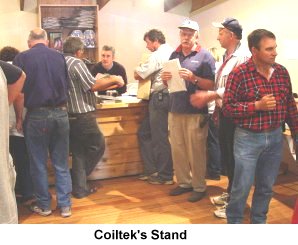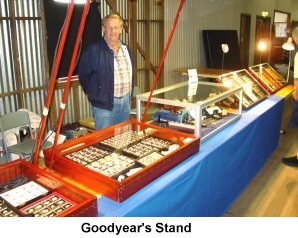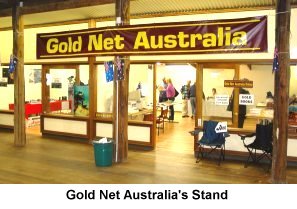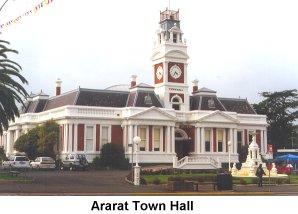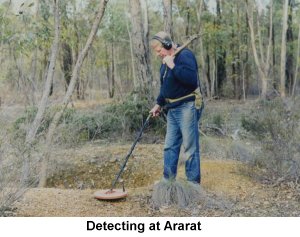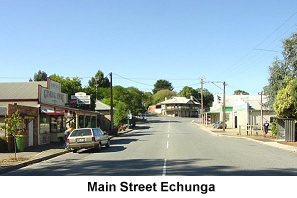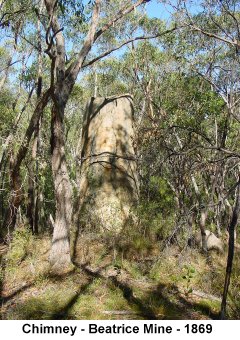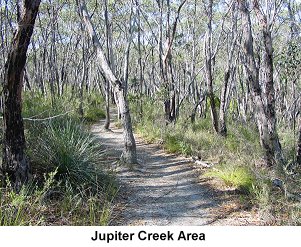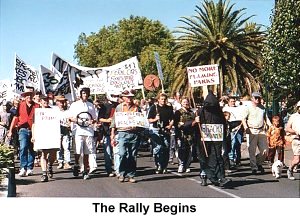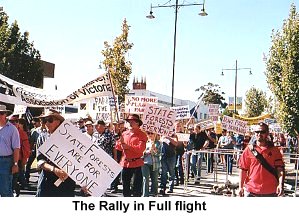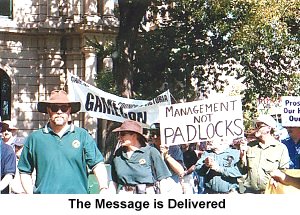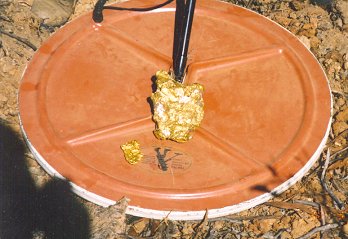
| April 2002 | ||||||||||||||||
|
||||||||||||||||
Contents
|
||||||||||||||||
1. EDITORIAL The 2002 Expo has been successfully completed for this year. It was a resounding success for all those who attended and participated. Once again the Expo was well attended - and was supported strongly by most major players within the industry. The absence of some - was not due to a lack of endeavour on our part to encourage those who are associated with the industry to participate. They were invited but chose not to attend. Our lead article presents an outline of the event - and it's success.
We have made some more changes to the Gold Net site and these changes will now be on-going.
The addition of the Kitco gold price index from New York - which updates every 10 minutes - along with a conversion calculator - is just the beginning.
We are pleased to advise that this site is now used as a reference source by both the Victorian and New South Wales Education Departments. The chat facility is still under construction - and we have been informed that it may be some weeks away due to pressure of work by the IT developers. None-the-less - it is coming - and soon.
Endeavours to source gold nugget markets overseas is paying off for Gold Net. The US buyer at the Gold Expo was testament to our efforts - and there were many prospectors who were able to sell big nuggets through this source - and we expect to have an on going relationship with buyers from overseas. The Protest Rally at Bendigo - on Saturday 23rd March - certainly drove home to the Bracks' Government that the silent majority WILL stand up and be counted - if pushed far enough. Rita Bentley sums up this event beautifully in her article this month. Editor Email: [email protected]
All material in this magazine is copyright and may not be reproduced in any part or form whatsoever without written permission from the publisher.
|
||||||||||||||||
2. THE GOLD EXPO - 2002 WRAP UP
 by Brad Williams Those who attended the second annual Australian Gold & Prospectors Expo were not disappointed. It could only be once again described as an outstanding success. Once again visitors from all over Australia attended this prestigious event.
During the set up phase on the Friday before the Expo - there was an air of expectation and camararderie
that flowed throughout the venue for the entire Expo.
The next morning Saturday dawned with a display of bright sunshine and a warmth in the air that was not expected for Ballarat. The weather turned out to be warm and sunny for the entire day - and it certainly set the scene for a successful event. MINELAB Minelab was there in force. Representing the most sophisticated metal detectors in the world today and with three experts answering questions about detectors in general - they were kept very busy. Minelab also provided a magnificent GP Extreme for a lucky visitor to the Expo. We are grateful for the contribution that Minelab makes in supporting the Exposition and the industry in general. Coiltek's display was awesome. With some outstanding new products and a complete new range of support gear, including some solar gear that was very innovative. This stand was extremely popular with new coils and as usual highly professional people including professional prospectors to provide assistance and guidance to prospectors. GOLD NET AUSTRALIA Gold Net displayed their on line magazine - along with a good selection of books relating to Gold Fields activities. John & Merle Harding assisted with this display and also presented an excellent display of gold jewellery for sale. MINERS DEN Miners Den presented with an outstanding array of detecting gear. This site was exceptionally busy for the duration of the Expo. Neville Perry the Expo's resident Gold Buyer also did a good trade. PMAV
The magnificent display and support of the PMAV was exceptional. OUTDOOR PRESS Doug Stone had a HUGE display of gold maps - some at discount prices - and his exhibit was well attended for the entire Expo. Doug's tours were also well promoted and no doubt many who attended will soon be out in the bush on detecting safaris with Doug.
Phil the Gold Man from Maryborough held the candle for Maryborough. Phils Gold Fossicking trips are well attended - and good business was done in promoting Maryborough and this wonderful golden area. PETER W BECK Peter W. Beck - was represented by Matthew Size - the General Manager. This organisation is a leading supplier of gold to the jewellery industry - and excellent contacts were made. GOODYEARS GEMS & JEWELS One of the most outstanding exhibits at the Expo was Goodyear's Gems. The quality of the nuggets and the jewellery was quite exceptional - and very unique. Trade was brisk for the two days of the expo. BARRIE JOHNSON DETECTOR SERVICE Barrie was the first to arrive and probably the last to leave. As one of Australia's leading Minelab dealers Barrie was extremely busy for the whole Expo. BALLARAT TOYOTA
Ballarat Toyota attended with an excellent array of high quality 4 wheel drive vehicles - which were very suitable for gold prospectors. Their display was well received and very well presented. The Minelab Dealer from Bendigo was quite busy with their display which included a broad range of detectors and associated accessories along with promoting gold tours in the gold field region in the vicinity of Bendigo. SPIRAL GOLDPAN This new and innovative product attracted great interest for Matt the Tiler at the Expo. The gold recovery displayed was excellent and sales for this product were good. GEKKO SYSTEMS This innovative company based in Ballarat and now with a turnover of $20 million a year mainly in exports presented a diplay that was both intriguing and informative. Medium range gold recovery equipment is their expertise and they are doing it extremely well. The Minister had arranged for members of her Department to attend to answer questions regarding issued of interest to Prospectors. The geologists who attended were extremely busy and their display and expertise was very well received. The topographic displays were excellent.
During both days Coiltek gave away coils.
Minelab - also donated a GP Extreme Detector valued at $5,200.00 We are presently in discussions with many interested players in planning future Expo's. Many innovative ideas are being considered and explored. We will advise of developments as time progresses. To all those that attended - we thank them sincerely - and look forward to a long relationship in the future.
|
||||||||||||||||
|
||||||||||||||||
3. ARARAT AND ITS GOLD by Sue "Goldie" Reynolds Ararat is close to the western edge of the auriferous ground in the Golden Triangle of Victoria. During the 1850's some gold had been found in the area - but not in the payable quantities like the Dunolly, Fiery Creek and Maryborough Gold Fields - which were favoured to the less attractive and unrecognised pickings further west.
However a political decision by the Government of Victoria which effected the massive numbers of Chinese who had been pouring into the Victorian gold fields was to change the face of Ararat for ever.
The Chinese pad indeed found thyeir Golden Mountain, with loads of wash dirt giving 25 ounces per wash load. An extremely rich reward indeed. The riches claims were generally shallow, and the auriferous area was extensive. Generally over 200 - 300 feet wide - but extending in some places to over 2,000 feet wide. It was about 2 miles long. It was indeed a "New Goold Mountain".
Several Chinese claims gave up an average of 130 lb of gold in a relatively small area.
Within 2 months the area had been flooded with a tidal wave of humanity with numbers recorded officially as up to 60,000 people.
The Ararat gold field continued to produce for 2 years - which was an outstanding feat - considering the great numbers of diggers who were still there. At the end of the two years however - the pickings were rather slim - and many diggers had in fact moved on to other more profitable gold fields. Today Ararat has a population of about 9,000 people, which in fact has declined in recent years from 12,000. Many people from Adelaide and Melbourne use Ararat as a rural retreat as some housing there is quite cheap. Some timber homes can be purchased for under AUD $40,000, which attracts buyers to purchase a weekender. And of course this a terrific place to base yourself in the gold fields - within quite a nice community with all the facilities - yet at cheap prices. I know of several prospectors who have done just that.
Ararat still produces good gold. Ironically the location of the main Chinese diggings has been lost, as many old maps indicate a general area only. Never the less detecting the ground at Ararat can be very rewarding, if you know what you are doing.
|
||||||||||||||||
|
||||||||||||||||
4. LOOKING TO ECHUNGA by Brad Williams
Echunga is a small hamlet tucked in the Adelaide Hills only about 40 minutes from the Centre of the city of Adelaide.
The area is rather thickly wooded and many areas are inaccessible and certainly not suitable for detecting - which is a pity as there is sure to be gold under those thickly wooded areas. Perhaps in the future the natural occurrence of bush fires might just open up this area - and if so - gold will be found there in good quantities.
The area to the south of the main gold field at Echunga displays patches of quartz interspersed with rolling paddocks of pasture.
Other gold fields in this region were the Biggs Flat diggings, Chapman's Gully, The Glen Taggart Gold Field, and Diamond Gully, named as diamonds were discovered there. Donkey Gully, near Mylor, Saw Mill Gully, north east of Mylor and Sailors and German Gully, which are close to the South East Freeway made up the rest of the Gold Field area. Gold was not discovered here until 1868 - and it was discovered by Thomas Plane - who had experience as a mounted constable serving with the gold escorts from the Victorian gold fields back to Adelaide. His interest in gold from that era - sparked him to find gold in the Adelaide hills - where he was eventually successful. In the initial rush about 1,200 people were on the diggings. Whites Gully, Fosters Gully, Golden Point and Surface Point were good producers with nuggets up to 12 ounces found. The gold here was limited, and in no way reflective of the great gold bonanzas in Victoria some 15 years before. Within a year the gold field was almost deserted.
Over several decades a number of companies were formed to recover the remaining gold - but all were unsuccessful. The last recognised gold recovery operations at the Jupiter Creek diggings were during the great depression in the early 1930's. Meagre pickings were recovered during this era. Today the area is sometimes visited by gold fossickers - but the dense undergrowth prohibits easy detecting of this area. No doubt there is still a lot of gold left in the ground here - but the topography is not conducive to gold recovery with detectors. However, it should be stated that in the last year I have heard of a 10 ounce specimen and a 6 ounce specimen being taken from the ground here. This area is still yet to be fully exploited for gold, as the auriferous areas and quartz throughout the region - in particularly to the south of the main Echunga diggings for many miles show good signs of gold. Unfortunately this ground is almost ALL privately owned. It's still out there folks - but it isn't easy to get.
|
||||||||||||||||
|
||||||||||||||||
|
5. THE PROTECT RALLY  by Rita Bentley
The Protest Rally that recently took place at Bendigo on Saturday the 23rd March, 2002 was a turning point of the debate regarding the establishment of yet more National and State Parks in Victoria.
Our links to theEureka incident of 1854, our heritage and culture was stressed by all speakers. Various politicians also addressed the crowd.
This entire sad saga resulted from a so called scientific investigation by the Environment Conservation Council. As a result they recommended the establishment of a series of large new National and State Parks and numerous nature conservation reserves across the box and ironbark region of Victoria. The areas causing most concern are situated at St Arnaud, Bendigo, Castlemaine, Heathcote/Greytown, Beechworth, Kingower, Wehla, Tarnagulla, Talbot, Maryborough. These areas are the heart of prospecting and mining activity in Victoria.
There is little scienctific evidence supporting the side of the pro-parks lobby. They, and Government, repeatedly state that only 17% of the original extent of box and ironbark forest remains.
The PMAV and other groups have been expressing their concern regarding the quality and integrity of the ECC's investigation - Government has steadfastly refused to listen.
Then there is a forecast huge influx of tourists to the region once the new parks are declared - just imagine bus loads of Japanese tourists hopping out to be bitten by march flies and mossies.
So what can you do to help? It is expected that Victoria will probably have a State Election within the next 12 months. The previous encumbent - Jeff Kennett was thrown out on the basis of not listening to the people. Steve Bracks will go the same way if his Government continues to ignore us on the parks debate.
Contacts:
|
||||||||||||||||
|
||||||||||||||||
6. THE DEATH OF LICOLA - PART 1 by Ralph Barraclough
This information sheet has been put together by the small community of Licola, in the mountains of Gippsland, beside the Alpine National Park. It is reprinted without alteration. When the park was proclaimed, it was promised to, protect the environment and bring even more visitors and prosperity to our area. What used to be thousands of fat cattle coming to town from the mountains dropped to just a few hundred. This has been reduced further by a ban on grazing after the Caledonia fire, because they "might" cause problems. 7,000 ha of regrowth (young timber), the Heyfield saw mills, and Heyfield itself, was dependant on, was burnt, this will now be on top of the 40-50% cut in quotasfrom DNRE miscalculations. Visitor numbers at times have dropped off alarmingly, with up to 70% drop in takings by the Licola Store after the fire. Around 98% of all visitors to our area are now prepared.to sign letters critical of park management. THE FIRE
This was a tax-payer funded $11,000,000 bushfire (it was probably more), brought about by the inability to control fuel levels in the park, and fight a fire. The fuel build-up from the lack of cool burning and reduction of cattle grazing was enormous. When the fire went through much of the alpine area, it was very intense. At the beginning on Dec 31, 1997, Park Rangers were in charge. Bulldozer drivers complained about lost bulldozers (at least 7) and poor supervision from Parks (one dozer spent several days needlessly bulldozing ancient snow gums along the side of the main road). Hoards of people (fire fighters) stood around for hours on end, day after day, in the fire area. Local people found it difficult to find anyone who had the experience, who understood, or cared that spot fires going outside control lines were serious and needed to he addressed.
In a crucial area near Tali Karng at 4-00am on Jan. 6, there was no patrolling, no blackening out and no foot prints along a bulldozed control line. Fires burnt in logs, trees and stumps, on the edge of the burn. A break-out escaping to the ridiculous fuel build-up in the Avon Wilderness, under the right conditions to threaten East Gippsland, would have been a certainty.
None of us had been advised of this by Parks/DNRE. With what we knew about the control lines, a break-out was a certainty if the right weather conditions came along. It would be hard to imagine a more stupid or ridiculous position to try and stop a fire. The Regional Officer for the CFA was to find out in May, from the Licola community about the fall-back position. During the fire, 1,000 ha of control lines and helipads were cleared by bulldozing. This is as much area disturbed in one fire, in one Park area, as has been in all mining activities in Victoria since settlement. The Tali Karng track, which was just starting, to grow back, was bulldozed, spoiling the environment for bushwalkers. Ancient single trunk snow gums of enormous historical and scientific importance, protected by years of cool burning and grazing, were burnt and bulldozed. lan Christie, Parks Victoria Executive responsible for fire liaison, in a letter dated 9 Sep 98, described the fire fighting as an "outstanding effort". Areas burnt out, like Charlies Country, had so much fuel they produced a fire so hot much of the seed-stock was lost and is not regenerating properly. Sphagnum bogs were destroyed, large rocks cracked, vegetation along creeks that should never he burnt was lost. Parks themselves admitted whole eco systems were destroyed. The fire burnt to near Tali Karng, killing much of a magnificent woolly butt stand that should have been preserved at all costs. The decimation with dead trees in the park, can be seen to stop at the boundary fence of Kevin Higgins property that practised traditional cool burning and grazing. Only a few weeks after the fire you had to look to see what had been burnt on his land.
|
||||||||||||||||
|
||||||||||||||||
7. FLECKS ! - Glints from here and there
|
||||||||||||||||
PALMER ROCK - A - RAMAMay 18 - 19 - 20th 2002. Collier Park - Palmer S.A.
Featuring
Sponsored by COILTEKCamping Welcome - Food - Entertainment - Gems - Prizes Fossicking - Gold Panning - Treasure Hunt & More Tailgating & Campsites available now For details or to book your site Write or Phone Now
|
||||||||||||||||
|
||||||||||||||||
8. STRIKES Recent Finds
|
||||||||||||||||
|
||||||||||||||||
|
9. THE NEW LODE - Next Month's Issue
|
||||||||||||||||
|
||||||||||||||||
